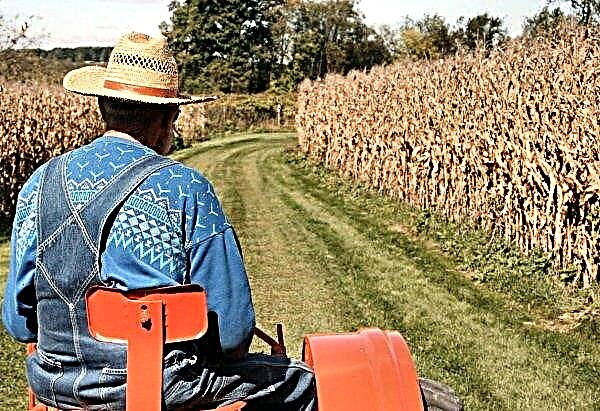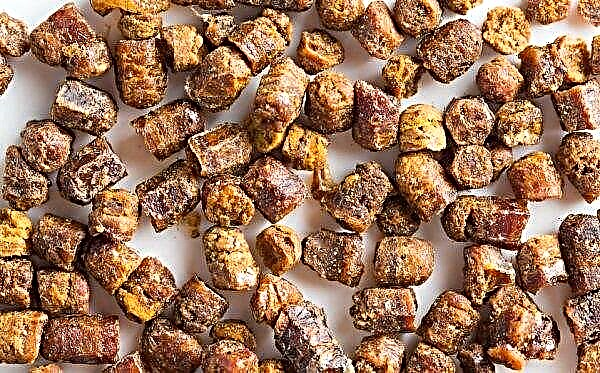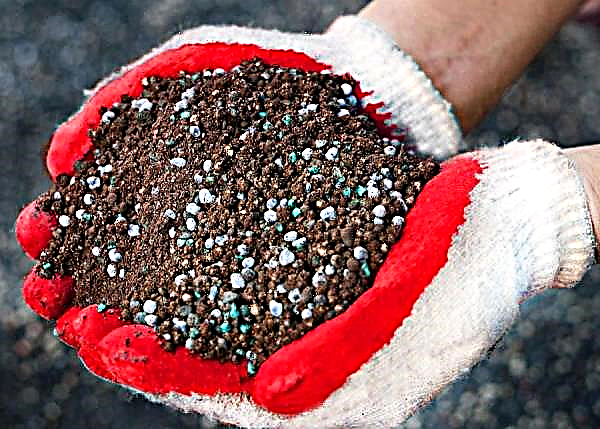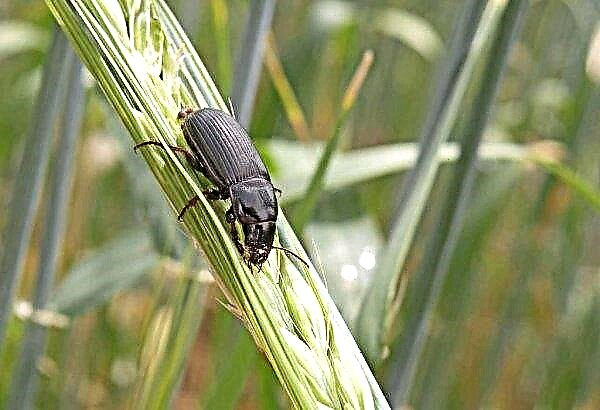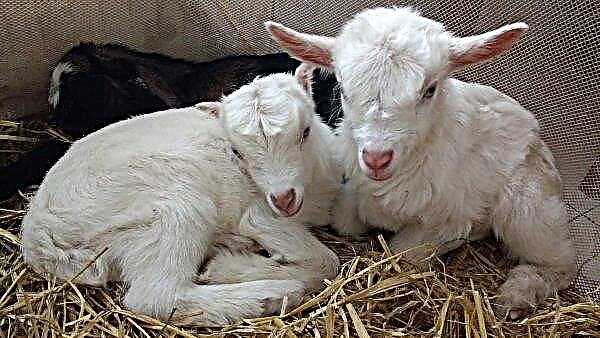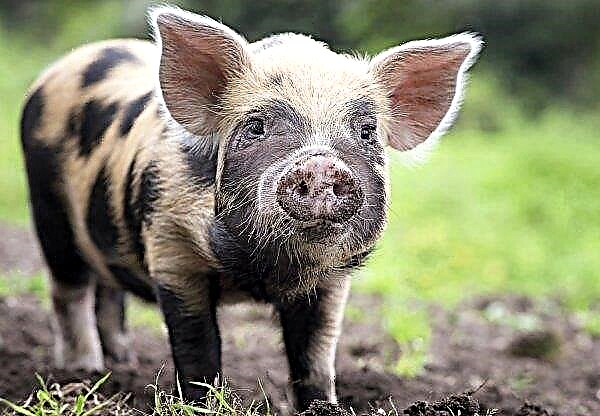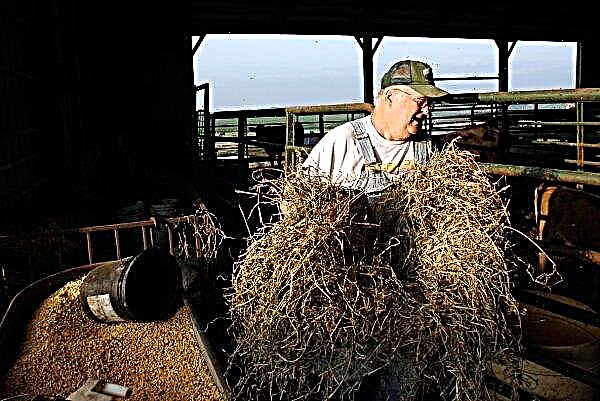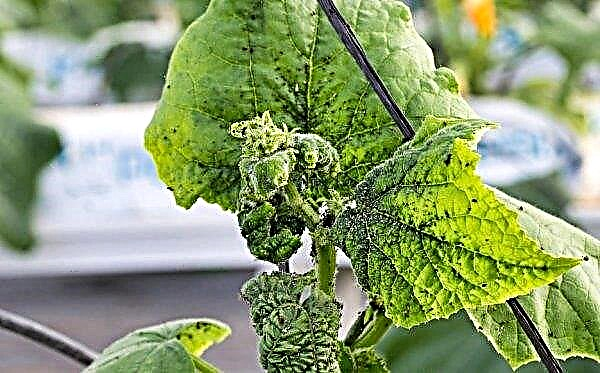The more active and longer the heat is present in the greenhouse, the more it corresponds to its name. Read more about how and how to warm a greenhouse in winter.
Winter greenhouse design
To ensure that in the winter period the polycarbonate greenhouse is not only fully supplied with heat, but also able to preserve this heat as much as possible, some efforts must be made to correctly orient it with respect to the wind rose, warming the foundation and soil.
Did you know? The prototype of a modern stove with the exit of the pipe outside the home was created as early as two hundred years before our era.
Cold Wind Isolation
If in your area the wind rose is characterized by some specific direction of the cold wind, which is predominant, then the greenhouse structure is placed along the motion vector of the winds. At the same time, in the end of the greenhouse, which is directed to the side where the wind mainly comes from, they build a main wall or equip a vestibule.

In all other cases, the greenhouse construction is oriented along the north-south line, equipping a vestibule of brick, stones, blocks or wood at the northern end. The southern end of the greenhouse is closed with a solid wall.
- The design of the vestibule has the following advantages:
- eliminates the blowing of heat from the greenhouse through door and window slots;
- as a thermal curtain prevents cold air from entering plants;
- makes it possible to place equipment for heating;
- with electric heating in the vestibule, it is possible to place an electric panel;
- the vestibule is a good equivalent of a storage room.
Foundation insulation
Typically, a greenhouse construction rests on concrete, strip or block foundations. To warm the foundation, a blind area is arranged around it, which protects the greenhouse soil from freezing. For this purpose, a layer of turf is removed along the entire perimeter of the foundation to a width of 0.5 m. Then make wooden formwork. The surface of the soil formed after removal of the turf is leveled with a small layer of sand, on top of which polystyrene insulation is laid. Then the blind area is either poured with a concrete layer over the reinforcing mesh, or paving stones are laid over the sand layer.
Then make wooden formwork. The surface of the soil formed after removal of the turf is leveled with a small layer of sand, on top of which polystyrene insulation is laid. Then the blind area is either poured with a concrete layer over the reinforcing mesh, or paving stones are laid over the sand layer.
Ground insulation
Measures to warm the soil inside the greenhouse allow you to separate the fertile soil layer from the lower cold layers of the earth and at the same time make greenhouse heating more efficient.
Important! In regions with particularly cold climates, it is recommended that the lower part of the greenhouse be insulated with foam concrete, wood or brick.
In order to qualitatively warm the soil in greenhouse beds, it is necessary:
- At the place of the proposed beds, dig a pit with a depth of at least 0.6 m, to the bottom of which pour a sand layer 0.05 m thick.
- Lay polystyrene insulation boards on top of the sand layer.
- Pour claydite layer up to 0.1 m thick on top, which performs drainage functions, while protecting polystyrene tiles when digging in the soil.
- Expanded clay layer to fill with fertile soil.
Types of heating systems for the greenhouse
Currently, many greenhouse heating systems have been developed that differ from each other in efficiency, cost of installation and operation, simplicity or complexity in maintenance. That is, the answer to the question of how to cheaply make heat in a greenhouse, like in the summer in the Kuban, can be varied and versatile.
Sunny
The transparent walls of the greenhouse make its interior space accessible to sunlight. In the spring-summer period, this is quite enough for complete heating of plants. In the autumn-winter period, a significant reduction in the sunny day and the ingress of sunlight on the beds at a very sharp angle minimizes the heating ability of solar energy.

To enhance these abilities, the following actions are taken:
- They create a slope of the greenhouse construction to the south, which increases the angle of incidence of sunlight on the ground and, accordingly, allows it to warm up better.
- Sheathe part of the walls, which are on the opposite side from the points of entry of the sun's rays, with light-reflecting material, which allows additional illumination and heating of plants.
- Black barrels of water are placed inside the greenhouse, which, as heat accumulators, accumulate heat during the day and give it to the surrounding air at night.
- Solar collectors are installed on the roof of the vestibule in the form of a system of pipes with water, which are placed in a heat-insulated casing coated with a transparent material, heated by solar energy and transfer the water heated inside them to the water heating circuit.
- They install solar panels on the tambour, which generate electricity, which is collected in the daytime by batteries located inside the tambour and fed by electric heaters at night.
Did you know? Central heating and underfloor heating were developed back in ancient Rome.
At the same time, solar collectors, which are used as a separate greenhouse heating type, as well as auxiliary ones, are quite expensive due to the need to equip a water heating system, but they are very economical during operation. Solar panels are also very expensive and also have a small capacity, which practically does not allow fully heating the greenhouse space.
Electric
Heating the greenhouse using electric energy is easy to install and operate, uses fairly cheap heating devices, quickly heats water and soil, and is easily automated. Disadvantages include high electricity tariffs.

With the help of electricity, the greenhouse is heated by:
- heating cable laid in the soil;
- convectors and electric heaters installed next to the main walls;
- infrared heaters that heat not the surrounding air, but the area falling into the infrared rays;
- electric boilers connected to water heating systems, which significantly increases the cost of their installation;
- film infrared heaters laid in the soil or through which plants take shelter in extreme cold.
Furnace heating
Most often, this type of greenhouse heating is presented:
- stove stove;
- buleryan furnace;
- brick oven.
As a rule, the furnace is installed near the north wall, and heat exchange with it is carried out:
- by natural convection;
- using ventilation;
- through the ducts.
Any firewood, coal and briquettes can act as heating oil.
- The advantages of stove heating include:
- quick start of heating;
- operational warming of the greenhouse space;
- fuel cheapness;
- simple installation and ease of operation;
- the possibility of creating a furnace on their own.
The disadvantage is the inability to automate the loading of fuel, because of which you have to break away from your business in order to go to the stove and toss firewood into it. A stove is a metal combustion chamber equipped with a door through which fuel is loaded.

At the bottom of the chamber is an ash pan, which is separated from the furnace by a grate. Gaseous products of combustion are discharged outside the greenhouse through a direct chimney. During the combustion of fuel, the walls of the stove heat up intensely and then send heat to the surrounding atmosphere.
- The advantages of a potbelly stove include:
- simplicity of design;
- its cheapness;
- the possibility of its independent manufacture;
- quick warm up;
- fuel availability.
- Among its shortcomings are called:
- high fuel consumption;
- low efficiency;
- uneven heating of the greenhouse space;
- drying greenhouse air;
- low heat capacity, expressed in very fast cooling of the furnace.
The buleryan furnace is an industrial-improved version of a potbelly stove. The main difference is the tubes mounted in the furnace, in which air circulates, entering from below in a cold state and leaving from above in a heated state.

- The advantages of the construction come from here:
- quite high efficiency;
- low fuel consumption;
- small dimensions of the furnace;
- evenly heating the space in which it is even easy for a person to warm up.
The main disadvantages of buleryan are the impossibility of its manufacture at home and low heat capacity, like that of a stove.
The brick oven is a major construction designed for year-round use. Its dimensions are determined by the greenhouse area. Typically, a brick oven is located near the main wall or in the vestibule.
- Its advantages include:
- increased heat capacity due to which the furnace is able to give off heat during cooling for half a day, or even whole days;
- low fuel consumption;
- infrared radiation, similar in spectrum to solar heat;
- wide selection of brick kiln designs.

- The disadvantages are:
- the complexity of the masonry, which requires a master stove;
- the need for laying a foundation under the furnace;
- sufficiently high price for the construction of the furnace.
Aerial
This heating system is most often used in large greenhouse constructions and is a heating unit installed in the center of the greenhouse. He pumps heated air into polyethylene sleeves with holes located along the perimeter of the greenhouse. The movement of heated air, although of much lower intensity, is also provided by electric convectors.

According to the principle of heating with hot air, fan heaters and heat guns work, blowing hot air into the greenhouse space. The main thing is to arrange them so that they do not damage the plants with hot air. The main common drawback of all these heaters is their high energy consumption.
Water heating
This method of heating the greenhouse space is the most reliable, but at the same time very costly when equipped, representing a whole complex for heating, consisting of:
- heating boiler;
- heating circuit from pipes with radiators and registers;
- expansion tank;
- pump for forced circulation of water.
Such a complex system is most often installed in large heated and heated greenhouses. When the greenhouse adjoins a house equipped with a water heating system, it is connected to the home system.
Otherwise, a separate boiler is required, which happens:
- diesel;
- gas;
- solid fuel;
- electric.
How to make a stove-potbelly stove and heat the greenhouse with it
The simplicity of the principle of operation of the potbelly stove, consisting in the rapid heating of the walls of the furnace and the chimney, is reduced to the simplicity of the manufacture of such a heater.

Definition with construction, location and foundation
The design of the body of the stove-potbelly stove varies and there are:
- frameless, in which the steel sheet forms the furnace body, for which the sheet is bent, and its edges are connected by welding, folding or riveting;
- frame, in the manufacture of which a frame is used, which serves as the basis for welding a steel sheet to it.
Potbelly stoves differ in the shape of the body, among which there are:
- round;
- rectangular;
- square.
Important! For more efficient heat accumulation, heat exchange intensification and fire safety, all parts of the furnace that are heated are subject to obligatory coating with furnace clay.
Also, furnaces of this type can be arranged in different ways, representing:
- a simple structure consisting of a steel tank equipped with a pipe on top and, on the other hand, with a fuel door;
- Improved design, which includes a box, a blower, a firebox with separate doors and a grate.
Potbelly stoves are installed either on metal profile legs or on brick trenches. The foundation for the stove-potbelly stove is designed to prevent distortion of the furnace due to the linking of the legs in soft soil.
Foundation work is carried out as follows:
Check out

- They dig a hole with a depth of 0.5 m and an area somewhat larger than the legs of the furnace.
- Then it is filled with broken brick and a mixture of crushed stone with sand.
- On top of a wooden formwork.
- Concrete solution is poured into it.
- Frozen concrete is covered with roofing material.
- 2 rows of burnt bricks are laid on top.
- Then blanks with an area of 0.5 x 0.7 m are cut from a sheet of steel.
- The workpiece is painted on both sides with oil paint and dried.
- Cut a felt plate of the same area and a thickness of 0.02 m.
- The felt is impregnated with a clay solution in the form of sour cream and laid on a steel sheet.
- After drying the felt, the sheet is laid on the foundation with felt down and fixed.
- Then the legs of the potbelly stove or its trenches are then placed on this sheet.
For the manufacture of the stove itself, it is necessary:
- Measure to optimally integrate the stove into the greenhouse and calculate the length of the chimney. It should be remembered about the future brick lining of the furnace.
- Make a drawing of the desired design.
- On sheets of iron, markup, according to which then grinder cut the bottom and walls.
- Weld the bottom and 3 lateral rectangular walls of the future furnace. Inside, weld metal corners that will hold the grate.
- The lattice itself is made of metal rods welded in the form of a lattice.
- On the top metal sheet, cut a hole for fixing the chimney.
- Then weld this sheet to the others already welded.
- On the front of the furnace, place the firebox and blower doors, weld metal loops for them and handles on them.
- To weld a piece of pipe into the hole in the upper part of the furnace, which will serve as the beginning of the chimney.
- Then weld metal corners to the bottom or to the ends of the furnace as legs of a potbelly stove.
Video: do-it-yourself potbelly stove for the greenhouse
Chimney and chimney outlet
The chimney may not necessarily be made of a whole pipe, it can be composed of pipe segments of the same diameter, but from different materials. All of them are connected with each other and with a hog welded with clamps to the top of the furnace. Joints are covered with oven clay.
The chimney is placed under a slight slope up, which is 1.5 cm per meter of length. For the stability of the hog, it is propped up in several places with props. In the vestibule, where the hog leaves the greenhouse, it ends with a chimney, which vertically passes through the roof and goes out.
At the top, the pipe is covered with a spark arrestor, which can be made from a can of canned food with many openings, and a cone that prevents atmospheric precipitation from entering the pipe. To adjust the draft and clean the chimney, a hole is made in it with a door called a view. In places where the chimney, passing through the roof, comes into contact with it, it is covered with layers of thermal insulation.
Water tank
It is the simplest, but very important part of the stove. Most often, a tank of water is located on top of the oven, but sometimes next to a heating wall. With the help of the water heated in the tank, the necessary humidity is maintained in the greenhouse.In addition, at hand there is always a supply of warm water necessary for watering plants.

Useful Tips
Experienced owners of polycarbonate greenhouses advise:
- During the combustion of a stove, a stove should be carefully monitored for the humidity of the wood, since it can lead to the formation of soot and condensate in the chimney, which significantly reduces its heat transfer and, accordingly, increases fuel consumption.
- When buying a finished stove, it is necessary to proceed from the fact that the passport indicates the volume of the room for which the stove is designed, located in a well-insulated building, and not in a polycarbonate-coated greenhouse, therefore it is necessary to purchase a heater in order to heat the greenhouse.
- It is useful to cover the chimney with chalk or lime, since the white color reflects well, and does not absorb mean rays of the sun in winter. In addition, traces of leakage of combustion products from the chimney will be immediately visible on the whitewash.


